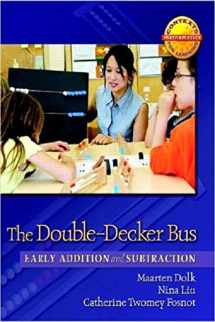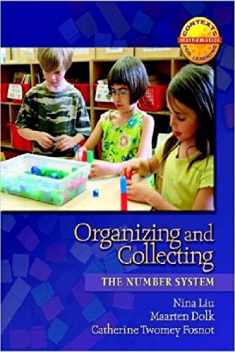
The Double-Decker Bus: Early Addition and Subtraction (Context for Learning Math)
ISBN-13:
9780325010083
ISBN-10:
0325010080
Edition:
1
Author:
Catherine Twomey Fosnot, Maarten Dolk, Nina Liu
Publication date:
2008
Publisher:
FirstHand
Format:
Paperback
96 pages
Category:
Education Theory
,
Schools & Teaching
FREE US shipping
Book details
ISBN-13:
9780325010083
ISBN-10:
0325010080
Edition:
1
Author:
Catherine Twomey Fosnot, Maarten Dolk, Nina Liu
Publication date:
2008
Publisher:
FirstHand
Format:
Paperback
96 pages
Category:
Education Theory
,
Schools & Teaching
Summary
The Double-Decker Bus: Early Addition and Subtraction (Context for Learning Math) (ISBN-13: 9780325010083 and ISBN-10: 0325010080), written by authors
Catherine Twomey Fosnot, Maarten Dolk, Nina Liu, was published by FirstHand in 2008.
With an overall rating of 3.6 stars, it's a notable title among other
Education Theory
(Schools & Teaching) books. You can easily purchase or rent The Double-Decker Bus: Early Addition and Subtraction (Context for Learning Math) (Paperback) from BooksRun,
along with many other new and used
Education Theory
books
and textbooks.
And, if you're looking to sell your copy, our current buyback offer is $0.3.
Description
The Double Decker Bus: Early Addition and Subtractionis one of eight units in the Contexts for Learning Mathematics' Investigating Number Sense, Addition, and Subtraction (K-3) This unit begins with the story of a double-decker bus-a bus that has two decks with ten seats on each. Five seats on each deck are red and five seats are white. The bus goes by quickly and the little girl in the story, sitting at her bedroom window and watching, works out ways to use the colors of the seats to calculate quickly how many people are on the bus. Her father drives a double-decker bus and she helps him figure out a way to know how many empty seats there are on the top deck even though he can't see them. The unit introduces the arithmetic rack as a powerful model and tool to act out the story. The arithmetic rack is a calculating frame consisting of two rows of ten beads-two sets of five (one red and one white) in each row. (Instructions for creating or buying your own arithmetic racks are included.) Cognitive psychologists, such as Susan Carey and Stanislas Dehaene (1999), have shown that even toddlers can recognize small amounts, such as two or three, as a unit and that this ability (known as "subitizing") is probably innate. Children can even do addition and subtraction with amounts of this size because they use this innate perceptual ability to see that three is one more than two. Using the arithmetic rack allows kindergarteners and first graders to build on their natural ability and see five as a unit. When five can be subitized as a whole, it can be used to support understanding of 6 as 5 + 1, 8 as 5 + 3, or 4 as 5 - 1. The arithmetic rack also supports the strategies of doubles and near doubles, 6 + 7 = 6 + 6 + 1, and making tens, 9 + 6 = 10 + 5. In this unit, children move the beads on the arithmetic rack to represent passengers going from one deck on the bus to the other, and sitting in various combinations in the red and white seats. This context supports the development of the understanding that numbers can be named in many ways, for example 10 as 6 + 4, 7 + 3, or 5 + 5. The unit also includes minilessons with quick images, and strings of related addition and subtraction problems solved with the arithmetic rack to help automatize the basic facts. Several games-Passenger Pairs, Rack Pairs, and Passenger Combos-are also included in this unit. They can be played throughout the year as a way for children to extend composing and decomposing strategies as they establish equivalence-for example, representing 7 as 5 + 2, 3 + 4, or 1 + 6 (Treffers, 1991). To learn more visit http://www.contextsforlearning.com


We would LOVE it if you could help us and other readers by reviewing the book
Book review

Congratulations! We have received your book review.
{user}
{createdAt}
by {truncated_author}




